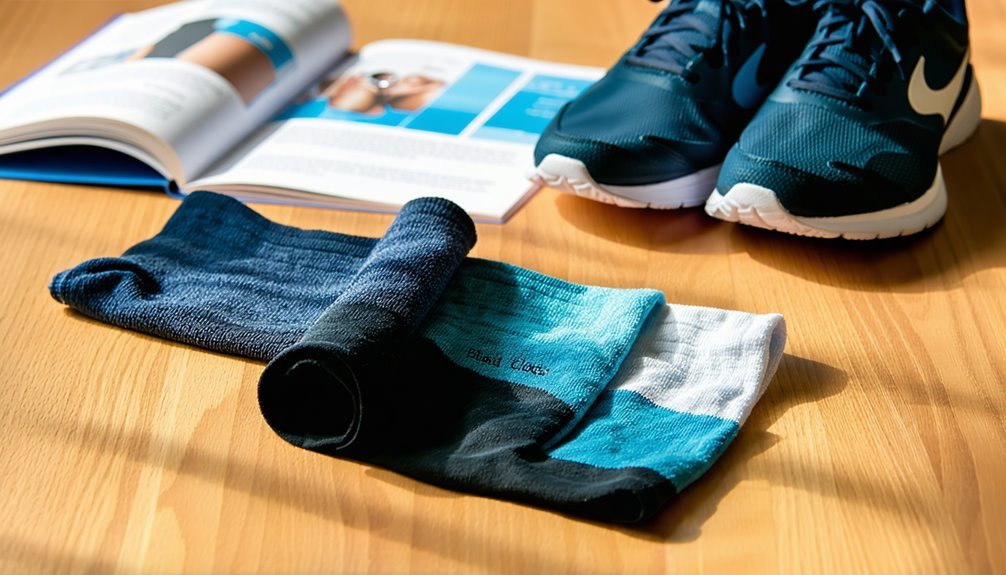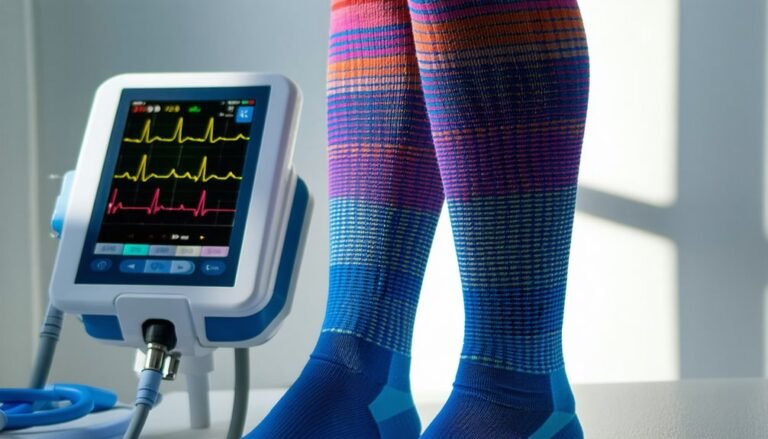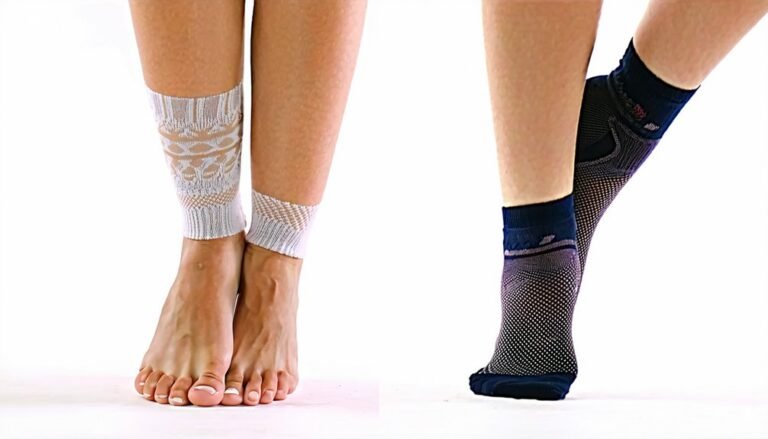Can Compression Socks Cause Blood Clots?
While compression socks promote healthy circulation and reduce blood clot risks, improper use or a poor fit can impede these benefits, potentially exacerbating circulatory issues. Ill-fitting socks can cause localized pressure, disrupting blood flow and heightening clot risks, particularly for individuals with conditions like peripheral artery disease or diabetes. It's essential to consult with healthcare professionals for proper sizing and compression levels to avoid complications. Understand the nuances of effective compression sock use and the importance of personalized guidance.
Understanding Compression Socks and Their Purpose

Compression socks, a staple in medical and athletic settings, serve an essential role in promoting circulatory health. By applying graduated pressure to your legs, these socks enhance blood flow from the extremities back to the heart. Different compression sock types, such as knee-high, thigh-high, and full-length, cater to specific needs based on individual health conditions and activity levels. Studies indicate that the blood circulation benefits include reduced risk of venous disorders, alleviated leg swelling, and improved overall leg comfort during prolonged periods of inactivity or high exertion. Selecting the right type of compression sock guarantees superior support and minimizes potential complications. Always consult a healthcare professional to determine the appropriate compression level tailored to your specific circulatory needs and safety requirements.
The Science of Blood Flow and Clot Formation
When examining blood flow and clot formation, it's essential to understand how your circulatory system functions. Various factors can influence clot formation, including immobility and genetic predispositions, which can impede normal blood circulation. Compression socks play a significant role by exerting pressure on your legs, promoting venous return and reducing the risk of clot formation.
Understanding Blood Circulation
Although often overlooked, understanding blood circulation is crucial for recognizing how blood clots form. Blood circulation is a complex system that delivers oxygen and nutrients to tissues while removing waste. Your venous health plays a critical role in this process. Veins transport deoxygenated blood back to the heart, aided by one-way valves that prevent backflow. When these valves function effectively, blood flows smoothly, reducing clot risk. However, when venous health deteriorates, blood can pool, increasing susceptibility to clotting. Maintaining proper blood circulation minimizes risks associated with clot formation. Compression socks can support venous health by applying graduated pressure, promoting efficient blood return. It's important to understand these dynamics to protect safety and prevent complications related to impaired circulation.
Factors Influencing Clot Formation
While various factors can influence clot formation, understanding the science of blood flow and clot formation is important to mitigating risks. Clotting disorders, such as thrombophilia, predispose you to excessive clotting, increasing your risk of developing deep vein thrombosis (DVT). It's essential to identify whether you have these genetic or acquired conditions. Lifestyle factors also play a significant role. Prolonged immobility, obesity, and smoking negatively affect blood flow, facilitating clot formation. Regular physical activity promotes healthy circulation, reducing the likelihood of clots. Additionally, hydration is critical, as dehydration thickens blood, heightening clot risk. Proper management of these factors, through medical consultation and lifestyle adjustments, aids in maintaining ideal circulatory health and minimizing the potential for harmful clot formations.
Role of Compression Socks
Compression socks are clinically proven tools that enhance venous return by applying graduated pressure to the legs. This pressure gradient aids in the efficient return of blood to the heart, greatly reducing venous stasis. You should understand that compression therapy benefits include improved circulation, which is vital for minimizing the risk of deep vein thrombosis (DVT). Clinical studies demonstrate that compression socks can decrease limb swelling and alleviate discomfort associated with prolonged immobility or standing. By ensuring ideal circulation improvement, these socks help maintain healthy blood flow dynamics and prevent clot formation. However, it is important to select the correct compression level and fit to maximize safety and efficacy. Always consult with a healthcare professional to determine the best compression strategy tailored to your needs.
Potential Risks Associated With Compression Socks
Despite their widespread use for promoting circulation and preventing deep vein thrombosis (DVT), compression socks aren't entirely without risk. Improper use or selection of compression socks can lead to compression risks, including impaired circulation. Ill-fitting socks may cause localized pressure that disrupts blood flow, potentially exacerbating circulation issues rather than alleviating them. Clinical studies indicate that over-compression can lead to skin irritation, numbness, and in extreme cases, worsen venous conditions. If you have peripheral artery disease or diabetes, these risks may be heightened, given the potential for compromised skin integrity. It's also vital to be aware of any existing medical conditions that might contraindicate their use. Always consult with a healthcare professional to guarantee compression socks are safe and appropriate for your specific needs.
How to Choose the Right Compression Socks

How do you guarantee you're selecting the appropriate compression socks for your needs? First, consider compression sock materials. Opt for breathable, moisture-wicking fabrics like nylon or spandex, which enhance comfort and durability. Next, focus on compression level selection. Compression socks are available in various strengths, typically measured in millimeters of mercury (mmHg). Light compression (15-20 mmHg) suits daily wear and mild swelling, while moderate (20-30 mmHg) is beneficial for varicose veins or post-surgery recovery. Higher levels (30-40 mmHg) should be reserved for severe conditions and require medical consultation. Verify the fit is snug, not tight, to promote effective circulation without discomfort. This evidence-based approach helps minimize risks, offering peace of mind and safety in your compression sock choice.
Expert Advice on Proper Usage
To optimize the efficacy of compression socks in preventing blood clots, ensuring correct sizing is vital; improper fit can lead to inadequate compression or discomfort. Evidence suggests wearing compression socks for the recommended duration, often during waking hours, maximizes their benefits while minimizing potential risks. It is important to consult a healthcare professional to tailor usage to your specific medical needs and to address any underlying conditions.
Correct Sizing Importance
Understanding the correct sizing of compression socks is vital, as improper fit can compromise their effectiveness and potentially exacerbate health issues. To guarantee accurate sizing, utilize sizing charts and proper measuring techniques. The circumference of your ankle and calf, along with the length of your leg, should be measured with precision. These measurements allow for the selection of compression socks that fit securely yet comfortably, minimizing the risk of reduced circulation or discomfort.
| Measurement Area | Importance |
|---|---|
| Ankle | Guarantees proper compression |
| Calf | Prevents excessive tightness |
| Leg Length | Ensures full coverage |
Adhering to these guidelines is vital for safe, effective use. Properly fitted compression socks can aid in preventing blood clots, providing peace of mind and promoting vascular health.
Wearing Duration Guidelines
When determining the ideal duration for wearing compression socks, it is crucial to take into account individual health conditions and activity levels, as well as expert recommendations. Evidence suggests that the wearing frequency and best duration depend on your specific needs. For those with chronic venous insufficiency or during long flights, wearing them daily for extended periods might be beneficial. Typically, experts recommend wearing compression socks during waking hours, as their efficacy diminishes when you're lying down. Make sure you remove them at night to allow skin to breathe. Overuse without breaks may lead to skin irritation or discomfort. Always monitor for any adverse effects, such as numbness or tingling, indicating that adjustments to your wearing routine might be necessary for safety.
Medical Professional Consultation
How do you guarantee you're using compression socks correctly? Seeking medical advice is vital. A healthcare professional can offer personalized recommendations based on your specific health conditions. They evaluate factors like your medical history, current medications, and potential risks. Professional opinions ascertain the correct fit, compression level, and duration of use, minimizing risks like blood clots.
Here's a guideline comparison:
| Aspect | General Use | Medical Advice |
|---|---|---|
| Compression Level | 15-20 mmHg | Tailored to condition |
| Duration of Wear | 8-10 hours | As prescribed |
| Fit Assessment | Self-measurement | Professional fitting |
Always prioritize safety by consulting your healthcare provider before using compression socks. Their guidance supports effective circulation and reduces the risk of adverse effects.
Recognizing Warning Signs and When to Seek Help
While compression socks can be beneficial in preventing blood clots, it's important to recognize the warning signs that may indicate the need for medical intervention. Be alert for symptoms such as persistent pain, swelling, redness, or warmth in the lower extremities, which may suggest a deep vein thrombosis (DVT). If you experience shortness of breath, chest pain, or a rapid heartbeat, these could indicate a pulmonary embolism, a severe complication of DVT. Immediate medical evaluation is critical in such instances. Don't hesitate to seek help if these symptoms arise, even if you believe they're unrelated to compression sock usage. Early detection and treatment are essential to prevent serious health outcomes. Prioritize your safety by being vigilant and responsive to these signs.
Frequently Asked Questions
Can Compression Socks Be Worn During Exercise or Sports Activities?
You can wear compression socks during exercise to enhance performance and recovery. The compression benefits include improved blood circulation, reduced muscle soreness, and decreased fatigue, promoting safer workouts. Guarantee proper fit to optimize these advantages.
Are There Any Specific Materials to Avoid in Compression Socks?
Did you know 80% of users find nylon-based compression socks most effective? When choosing compression sock materials, avoid latex if you have allergies. Guarantee sock compression levels match your needs for safety and efficacy in circulation improvement.
How Long Can Compression Socks Be Worn Each Day?
For best safety, verify your compression socks fit properly. Evidence suggests wearing them for a daily duration of 8-12 hours. Overuse might cause discomfort, so monitor any signs of irritation or circulation issues during prolonged wear.
Do Compression Socks Require Any Special Washing or Maintenance?
To guarantee longevity and effectiveness, you should follow specific washing techniques and maintenance tips. Hand wash in lukewarm water, use mild detergent, and air dry. Avoid bleach and fabric softeners to maintain compression integrity and guarantee safety.
Can Compression Socks Be Used During Pregnancy?
Yes, you can use compression socks during pregnancy. They're beneficial for reducing swelling and improving circulation. Ascertain the compression level is appropriate, typically 15-20 mmHg, and consult your healthcare provider for personalized advice on pregnancy benefits and safety.







